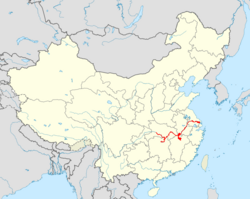Biology:Neophocaena asiaeorientalis asiaeorientalis
| Yangtze finless porpoise | |
|---|---|
| Scientific classification | |
| Domain: | Eukaryota |
| Kingdom: | Animalia |
| Phylum: | Chordata |
| Class: | Mammalia |
| Order: | Artiodactyla |
| Infraorder: | Cetacea |
| Family: | Phocoenidae |
| Genus: | Neophocaena |
| Species: | |
| Subspecies: | N. a. asiaeorientalis
|
| Trinomial name | |
| Neophocaena asiaeorientalis asiaeorientalis (Pilleri & Gihr, 1972)
| |

| |
| Yangtze finless porpoise distribution | |
The Yangtze finless porpoise (Neophocaena asiaeorientalis asiaeorientalis) is a species of mammal in the family Phocoenidae. It is the only remaining cetacean species in the Yangtze River, China following the possible extinction of the baiji (Lipotes vexillifer).[2] However the population decrease is accelerating due to lack of food, pollution and ship movement and has a high chance (86.06%) of being extinct within the next 100 years.[3]
Diet
The diet of the Yangtze finless porpoise may vary according to the season and the dominant prey of the season. This variation in their diet suggest that the Yangtze finless porpoise may be opportunistic feeders. Among the fishes in their diet, the most common are Coilia brachygnathus, Pseudobrama simoni, Pelteobagrus nitidus, and Hemiculter bleekeri.[4]
References
- ↑ Wang, D.; Turvey, S.T.; Zhao, X.; Mei, Z. (2013). "Yangtze Finless Porpoise". IUCN Red List of Threatened Species 2013: e.T43205774A45893487. doi:10.2305/IUCN.UK.2013-1.RLTS.T43205774A45893487.en. https://www.iucnredlist.org/species/43205774/45893487.
- ↑ "WWF Yangtze Finless Porpoise". https://www.worldwildlife.org/species/yangtze-finless-porpoise.
- ↑ "Accelerating population decline of Yangtze finless porpoise". https://www.sciencedirect.com/science/article/abs/pii/S0006320712002248.
- ↑ Yang, Jiwei; Wang, Kang; Mei, Zhigang; Xu, Jun; Zheng, Jinsong; Wan, Xiaoling; Hao, Yujiang; Wang, Kexiong et al. (2021). "Temporal variation in the diet of Yangtze finless porpoise calls for conservation of semi-migratory fish". Freshwater Biology.
Wikidata ☰ Q61887190 entry


